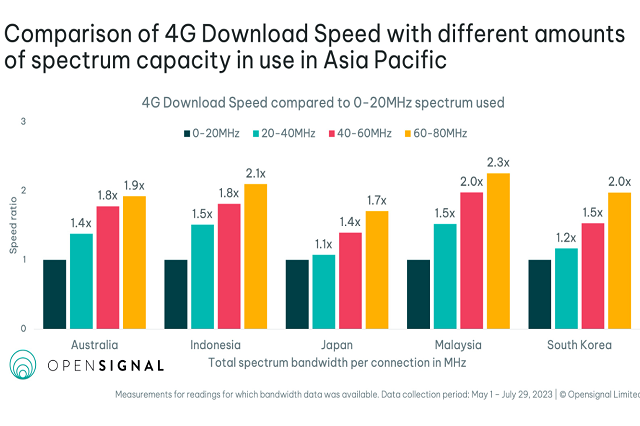Mobile metrics firm Opensignal recently bared a new analysis examining how greater quantities of spectrum capacity contribute to improved 4G and 5G experience in the Asia Pacific region.
Opensignal data shows that Asia Pacific users observe twice or even thrice as fast 4G download speeds and around 50% faster 5G download speeds when there are large amounts of spectrum bandwidth connected compared with low amounts.
Video streaming services also benefit from increased spectrum bandwidth — however, the difference is more marked on 4G than 5G.
In Asia Pacific, higher average spectrum bandwidths lead to faster 4G and 5G download speeds, the company said, adding that there is a substantial and positive correlation between the average spectrum bandwidth used for 4G and 5G connections and the average 4G and 5G download speeds seen by users.
The link is stronger for 4G than for 5G, the company added.
Malaysia benefits most from wider spectrum bandwidth, Opensignal said, adding that the country has nearly twice as fast speeds for 40-60MHz, compared to the 0-20MHz bandwidth as a base reference — and 2.3 times faster for the 60-80MHz spectrum capacity.
Opensignal further said 4G download speed is more than double in Indonesia where more than 60MHz spectrum is used, compared to 0-20MHz — and is nearly twice as high in Australia and South Korea using respective bandwidths.
Users in Japan observe a smaller relative impact of more spectrum used for 4G connectivity — average 4G download speeds are only around 40% faster for 40-60MHz bandwidths and slightly more than 70% faster for 60-80MHz, it said.
Modern smartphones typically connect to multiple spectrum bands, or carriers, at once, Opensignal said.
Opensignal also said it looked at the average 4G download speeds in Asia Pacific with five different amounts of spectrum bandwidth connected.
These bandwidth sizes reflect the total spectrum in use, across all the carriers that are connected. On 4G the maximum bandwidth on a single carrier is 20MHz, while using 5G the total bandwidth per connection can be up to 100MHz.
With carrier aggregation, the total amount of spectrum in use can exceed both the 20MHz 4G limit and 100MHz single carrier limit because multiple carriers are connected at once.
When users are connected with greater amounts of 4G spectrum bandwidth, they experience much faster average 4G download speeds across Asia Pacific markets, the report said. While 5G has launched in many markets, 4G is still prevalent across many markets in the region and continues to contribute to the 5G experience when users connect to 5G with non-standalone access (NSA).
Average 4G download speeds for the 20-40MHz spectrum bandwidth used — meaning at least two 4G carriers are in use — clock in at 35.1Mbps, 55.2% faster than for connections using spectrum capacity of 20MHz or less.
The 4G Download Speed score is even higher with at least three carriers used and more than 40MHz spectrum connected. Then users see average speeds of 46.4Mbps, or more than twice as fast as when there is 0-20MHz spectrum in use.
With more than 80MHz of mobile spectrum connected, average 4G download speeds in Asia Pacific rise to 64.1Mbps which is nearly three times faster compared to speeds with just 0-20MHz connected.
More spectrum bandwidth also boosts 5G Download Speed in the Asia Pacific region significantly. When smartphones are connected with more than 100MHz of total spectrum capacity, average 5G download speeds clocks in at 271.4Mbps.
This is approximately a 50% increase in 5G Download Speed compared with 5G speeds with a spectrum bandwidth of 100MHz or less. However, there is only a 3.3% increase in 5G Download Speed for the 50-100MHz bandwidth used, compared to 0-50MHz.
Looking at selected Asian Pacific markets, the trend of more spectrum used contributing to a faster average 4G Download Speed continues. Out of the markets analyzed, Malaysia benefits the most from wider spectrum bandwidth.
“We observe nearly twice as fast speeds for 40-60MHz in Malaysia, compared to the 0-20MHz bandwidth as a base reference — and 2.3 times faster for the 60-80MHz spectrum capacity. However, for 5G, the situation is different, as Malaysia holds a 5G single wholesale network, leading to relatively low usage levels,” the report said.




